Silverhill
and the
Peoples Railroad
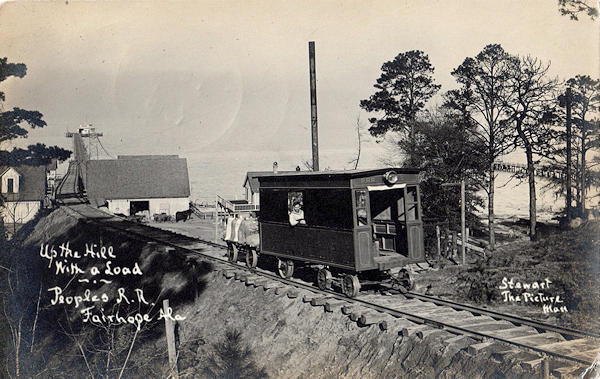
|
A Section of the Peoples Railroad in Fairhope, 1915.
Select to view larger size.
|

Silverhill had two opportunities for a railroad to pass through their town. The initial chance arose in 1903 when the Louisville and Nashville Railroad, or L&N, planned to extend their line from Bay Minette to Fort Morgan. However, engineers and surveyors discovered a more suitable route to the east of Silverhill, prompting a change in plans. Consequently, in 1905, the Silverhill Train Depot was constructed three miles east of the town center, in what would later develop into Robertsdale.
Silverhill had another chance for a railroad in 1912. People from Fairhope, located on the eastern side of Mobile Bay, wanted to link their area with the L&N line to the east of Fairhope.
|
Since Fairhope's founding in 1894 by cofounder Ernest B. Gaston, its residents had long felt the need for improved transportation routes. Relying primarily on bay boats to reach Mobile via the colony's wharf, the idea of a railroad connecting them to the inland regions had been a persistent dream. On March 6, 1912, Ernest B. Gaston, also the editor and publisher of The Fairhope Courier, read an article in the Mobile Register. The dream was renewed. Two days later, E.B. Gaston reprinted the article on the first page of his newspaper, along with his own comment.
|
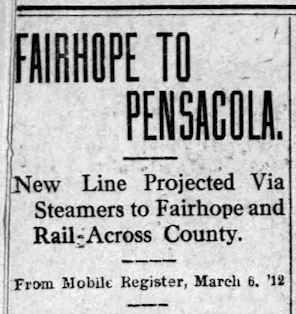
Printed in The Fairhope Courier March 8, 1912.
(Select to read entire article and view in larger size.)
|
When the readers of The Fairhope Courier saw this article, informing them that "Northern capitalists" were interested in Baldwin county lands to construct a railway, interest was sparked. Fairhopers were upset that the proposed railroad bay terminal would likely be constructed south of Fairhope, possibly at Zundel's wharf south of Point Clear.
The Fairhope Single Tax Colony who completed their own wharf December 1895, would not see any of the profits from this venture if the new railway ran south of Fairhope. Wharfage, the fee charged for utilizing the wharf, would be directed to another community. They had recently recovered from two disasters damaging the wharf. The 1906 hurricane had washed it away and a fire in 1910 caused costly repairs to the pier head.
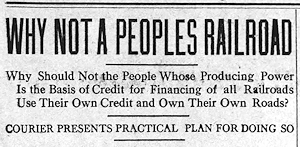
Printed in The Fairhope Courier March 15, 1912. (Select to read entire article and view in larger size.)
|
E.B. Gaston's next article on the railroad was his suggestion of starting a corporation to begin their own railroad company. He proposed making it not for profit and no stock issued, with plans to solicit subscriptions toward building the road.
|
|
Ernest Berry Gaston was born November 21, 1861 in Henderson, Illinois. Better known as E.B. Gaston, he was not only editor and publisher of The Fairhope Courier, he was also a cofounder of the Fairhope Single Tax Colony and served as its council secretary. He was 50 years of age when he wrote the above article presenting a plan for the railroad. He died in Fairhope, Alabama at the age of 76 on December 23, 1937.
|
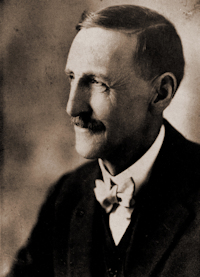
Ernest Berry Gaston
|
E.B. Gaston continued printing articles on plans for the railroad. With hopes that the communities to the east of Fairhope would support the road, he paid a visit to Silverhill and printed the report of that visit.
Afterward, E.B. Gaston had received numerous visits and letters from people in support of his railroad idea. Silverhill's founder, Oscar Johnson wrote the editor, endorsing the construction of the railroad. After this approval, plans were made to route the railroad through Silverhill to the L&N station in Robertsdale.
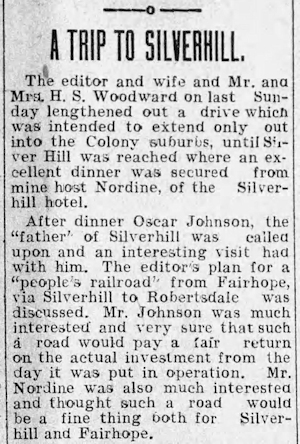
Printed in The Fairhope Courier March 22, 1912. (Select to read entire article and view in larger size.)
|
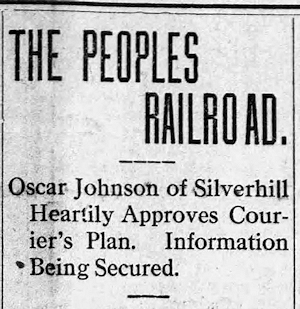
Printed in The Fairhope Courier April 19, 1912.
(Select to read entire article and view in larger size.)
|
E.B. Gaston reported in his paper on April 26, 1912, that presently the L&N railroad charged a fare of $1.50 to ride the train from Robertsdale through Bay Minette to Mobile. Also, that it was not possible to return in the same day, requiring an overnight stay in Mobile. The proposed Peoples Railroad would only charge three cents a mile, making the 15 miles between Robertdale to Fairhope cost 45 cents. The boat fare from Fairhope to Mobile would be 25 cents, costing a total of 70 cents to travel from Robertsdale to Mobile. This would allow people to have six hours time in Mobile with enough time to return the same day.
|
The next week, E.B. Gaston reported in his paper on May 3, 1912, that a public meeting would be held the following week in the Fairhope auditorium at the Organic School.
Later, he reported that there was a good attendance at the meeting, which he had directed. He was also elected the secretary of a committee of five people to draft a charter of incorporation and ascertain its costs.
|
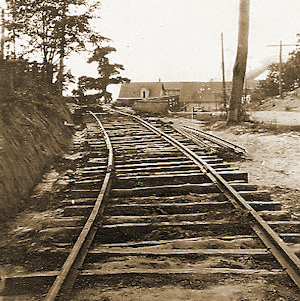
A section of the Peoples Railroad near the bay. The wharf is visible on the right in the distance.
(Select to view larger size.)
|
The June 7, 1912 edition of the paper reported that the committee on organization for building the Peoples Railroad had received word from their attorneys in Mobile that a non-profit corporation could be formed to build a railroad without capital stock and having a membership fee only. The committee agreed that they would form a corporation with a membership fee of $5.
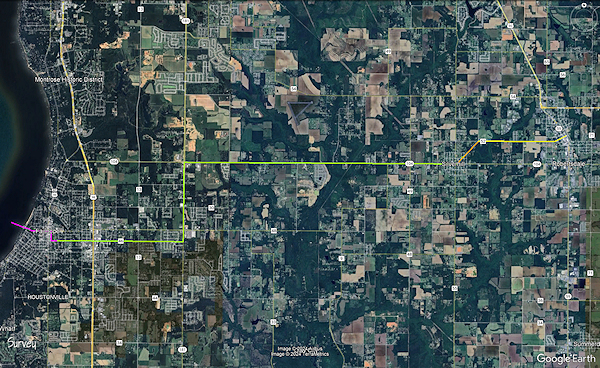
|
A modern map of Baldwin County showing the proposed route of the Peoples Railroad.
Select to view larger size.
|
The September 13, 1912 newspaper edition announced that the Judge of Probate had returned the Charter of Incorporation with approval for its completion. It had been signed and recorded. E.B. Gaston printed the entire Constitution of the Peoples Railroad Company in that edition.
In the October 18, 1912 paper, E.B. Gaston printed the results of the election of officers for the Peoples Railroad Company.
President, E. B. Gaston, Fairhope.
Vice president, Rev. Carl G. Johnson, Silverhill.
Secretary, E. G. Dougherty, Fairhope.
Treasurer, Wm. McIntosh, Robertsdale. (Cashier Bank of Robertsdale.)
Each town elected their own railroad committee. This was the Silverhill directors:
O. F. E. Winberg,
Charles Lyrene,
Rev. Carl G. Johnson,
B. Lindberg, alternate.
They voted to proceed with building the railroad with the funds that had been collected already through membership fees. First, the rights of way needed to be secured, then clearing and grading the land, before laying down the tracks. They believed if the public saw progress on the road, more would pay subscription memberships. The treasurer said the balance on hand was $198.78. Land surveys had already been completed. Plans were made to seek financial assistance in Chicago. Also, bonds with a six percent interest of twenty years were in the plans.
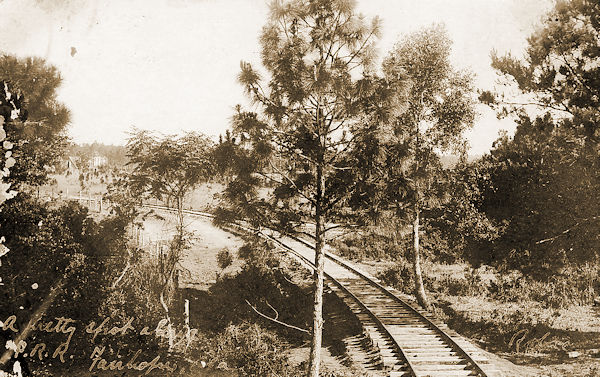
|
A pretty spot along P.R.R. Fairhope, Ala - written on the bottom left. On the right bottom is the photographer's signature, Edwin Robac. He took a number of views of the railroad in May 1915.
Select to view larger size.
|
On October 25, 1912, the paper stated that the Fairhope Single Tax Corporation had agreed to transfer control of the wharf, along with its annual income of approximately $25,000, to the Peoples Railroad Company for the following five years. In return, the Peoples Railroad Company would be responsible for the maintenance and repairs of the wharf after the first mile of track had been laid.
At the end of the year, the December 27, 1912 edition of the paper reported that work would soon begin on the railroad, starting at both ends. They wanted the west end at Fairhope to be in operation from the end of the pier to the town area. At the east end, they wished for the three miles from the L&N station in Robertsdale to be finished all the way into Silverhill.
At the start of the new year 1913, E.B. Gaston prepared a thirty-two page pamphlet and ordered 3000 copies printed. He also printed an entire copy of it in his paper. Below is a copy of the booklet.

Promotional Booklet for
The Peoples Railroad
Printed in January 1913
Click each page to Enlarge.

The Peoples Railroad Booklet back cover and front cover. Published in 1913 by E.B. Gaston, editor of The Fairhope Courier.
|

The Peoples Railroad Booklet inside front cover and page 1. Published in 1913 by E.B. Gaston, editor of The Fairhope Courier.
|

The Peoples Railroad Booklet page 2 & 3. Published in 1913 by E.B. Gaston, editor of The Fairhope Courier.
|

The Peoples Railroad Booklet page 4 & 5. Published in 1913 by E.B. Gaston, editor of The Fairhope Courier.
|

The Peoples Railroad Booklet page 6 & 7. Published in 1913 by E.B. Gaston, editor of The Fairhope Courier.
|

The Peoples Railroad Booklet page 8 & 9. Published in 1913 by E.B. Gaston, editor of The Fairhope Courier.
|

The Peoples Railroad Booklet page 10 & 11. Published in 1913 by E.B. Gaston, editor of The Fairhope Courier.
|

The Peoples Railroad Booklet page 12 & 13. Published in 1913 by E.B. Gaston, editor of The Fairhope Courier.
|

The Peoples Railroad Booklet page 14 & 15. Published in 1913 by E.B. Gaston, editor of The Fairhope Courier.
|

The Peoples Railroad Booklet page 16 & 17. Published in 1913 by E.B. Gaston, editor of The Fairhope Courier.
|

The Peoples Railroad Booklet page 18 & 19. Published in 1913 by E.B. Gaston, editor of The Fairhope Courier.
|

The Peoples Railroad Booklet page 20 & 21. Published in 1913 by E.B. Gaston, editor of The Fairhope Courier.
|

The Peoples Railroad Booklet page 22 & 23. Published in 1913 by E.B. Gaston, editor of The Fairhope Courier.
|

The Peoples Railroad Booklet page 24 & 25. Published in 1913 by E.B. Gaston, editor of The Fairhope Courier.
|

The Peoples Railroad Booklet page 26 & 27. Published in 1913 by E.B. Gaston, editor of The Fairhope Courier.
|

The Peoples Railroad Booklet page 28 & 29. Published in 1913 by E.B. Gaston, editor of The Fairhope Courier.
|

The Peoples Railroad Booklet page 30 & 31. Published in 1913 by E.B. Gaston, editor of The Fairhope Courier.
|

The Peoples Railroad Booklet page 32 and inside back cover. Published in 1913 by E.B. Gaston, editor of The Fairhope Courier.
|

E.B. Gaston reported that land had already begun to be cleared between Silverhill and Robertsdale during the first half of February 1913. He also tried to explain how the not for profit company would have their attorneys form bonds and secure a mortgage from the City Bank and Trust Company of Mobile. By the end of February, the directors were authorized to issue $150,000 in bonds. The sale of these bonds would provide the funds for building the road.
Each town elected their own railroad directors in March 1913. These were the Silverhill directors:
O. F. E. Winberg,
Charles Lyrene,
Rev. Carl G. Johnson,
Oscar Johnson.
In the April 4, 1913 paper, E.B. Gaston reported that he had visited Silverhill and Robertsdale. There he found that a lot of work had been done on that section of the railroad. The entire right of way had been cleared of trees and stumps, fences set back, and considerable grading accomplished. Most of the area was ready for the ties to be laid. He did not explain whether or not the local workers had been paid for their efforts, or if it was volunteer labor.
While in Silverhill, Oscar Johnson gave Ernest B. Gaston a subscription in writing that his sawmill could deliver 800 ties at a price that was less than their engineer's estimate. The rails were to be leased from a railway company.
Fairhope had seen little progress compared to Robertsdale and Silverhill, where residents had invested considerably more time and effort in preparing their section of the railroad line. In Fairhope, the community anticipated that a construction crew would handle this task rather than taking it on themselves. However, the expected funds failed to materialize, and the Chicago construction company slated for the project withdrew, citing financial constraints. Subsequently, railroad contractors in Alabama were approached for assistance.
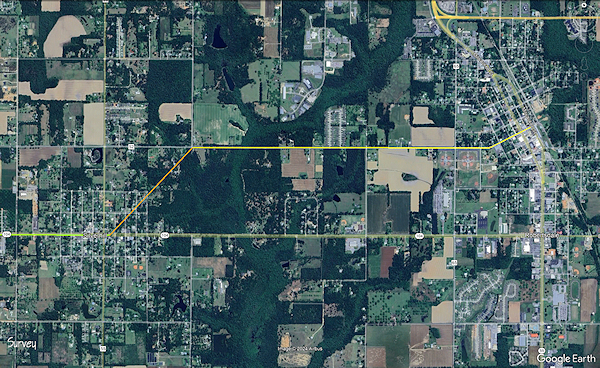
|
A modern map of Baldwin County shows the planned eastern route of the Peoples Railroad. During the spring of 1913, the proposed road between Silverhill and Robertsdale had been prepared. The right of way had been cleared of trees and stumps, fences set back, and grading done on the area marked with a yellow line. There was planned a connection of the railroad to the center of Silverhill, loosely marked by the orange line. The proposed road through Silverhill would run from Robertsdale, past the sawmill then past the creamery before turning west just before the market area in the center of town. It would continue west to Fairhope on the green line marked on the map.
Select to view larger size.
|
In late July 1913, the Fairhope railroad directors convened and opted to proceed with the construction of the first mile of road from the wharf into town using the available funds. Rather than engaging a construction company, they resolved to enlist local workers who would accept bonds as compensation for the majority of their labor.
The editor reminded the readers of the paper that subscriptions to the bonds of the Peoples Railroad Company were not donations. They were a safe investment at a good rate of interest. The bonds were issued in denominations of $25, $100 and $500 bearing interest at 6 per cent, per annum and could be paid for in installments.
The City Bank and Trust Company of Mobile had been chosen as the trustee for the bondholders. The bank was not purchasing or financing bonds, nor were they underwriting or guaranteeing the principal or interest of the bonds, but merely acting as the trustee.
Work suspended for several months because of lack of funds. The election of officers for the new year was held in March 1914. Two years after the conceptualization of the Peoples Railroad Company, and there was still no railroad built. A trestle at the end of the wharf climbing up the ravine, which would prove to be the most difficult part of the construction, had yet to be built. Land had been prepared past this point for one mile. The wooden ties were cut waiting for the rails.
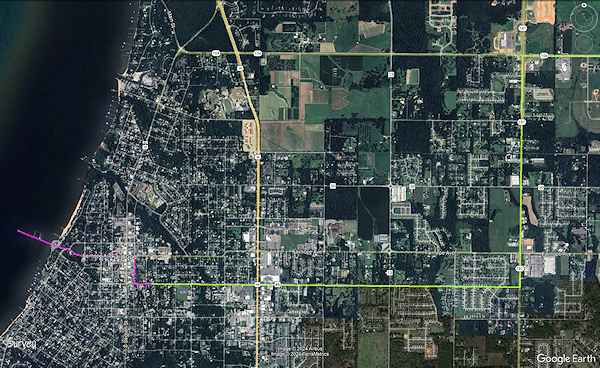
|
A modern map of Baldwin County showing the proposed route of the Peoples Railroad. The only section of the railroad that was ever completed is marked by the pink line. The proposed route continued east on the green line. It was never completed.
Select to view larger size.
|
E.B. Gaston persisted in utilizing his newspaper to appeal for additional investments in the project. He went as far as publishing a list of contributors along with the amounts they had paid. Notably, railroad news often graced the front page, highlighting its significance.
In mid July 1914, the trestle was finally finished. Completing the first mile of railroad was delayed. There were still no rails. There were problems with shipping delays and receiving the correct size of rails.
The August 14, 1914 edition of the paper reported that the rails for the first mile had arrived at the Fairhope pier and were already being laid. There were many repairs needed on the wharf including replacing old pilings and adding extra stringers.
A 60 horsepower Thomas Flyer had been purchased and was in the process of being converted into a railway motor car able to carry about 16 passengers and pull a trailer.
Even before the body for the railway car was constructed, the car was pressed into service for the first time on September 9, 1914. Essentially, it functioned as a motor car with a frame, tasked with pulling a trailer to transport metal rails uphill for installation on the ties. The trailer itself was repurposed from an old wharf freight car.
Saturday, September 12, 1914, was the first time the railway car carried passengers. It was named the Peoples Railway motor car No. 1. It was hastily equipped with rough temporary seats. The trailer it pulled carried a couple of benches back to back in the center. The benches were borrowed from the bay boat Apollo. The car met the boat and brought a load of passengers up to the town at 5 cents a person.
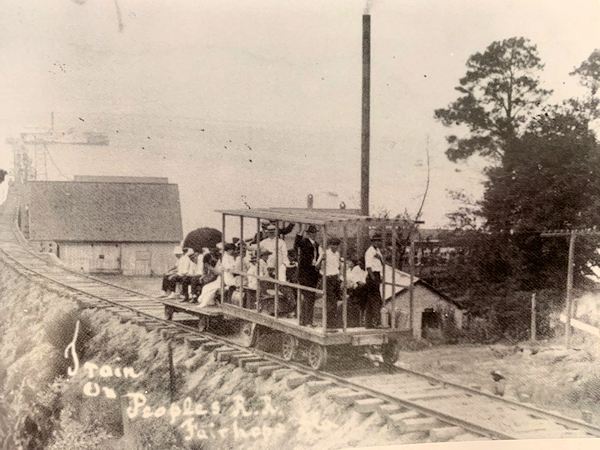
|
The Peoples Railway motor car before the wooden body was finished, about September 1914.
Select to view larger size.
|
|
Just as the railroad was beginning operations, an accusation was made which was reported to the Post Office officials, that Ernest B. Gaston was committing mail fraud. The officials investigated the charge and then dismissed it.
|
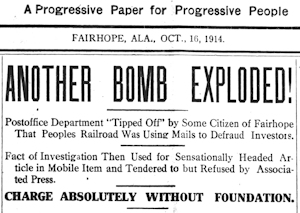
Printed in The Fairhope Courier October 16, 1914. Page 1. This article expands further. Its continued page is below.
|
Although the charge was dismissed, it is understadable why the public could see a problem. There did seem to be a conflict of interest on E.B. Gaston's part, since he was editor of The Fairhope Courier, and secretary of the Fairhope Single Tax Colony, and President of The Peoples Railroad Company. He was continually printing the progress of the railroad on the first page of his paper and commenting that the road was in need of investors, nearly to the point of pleading. The newspaper was delivered to the public by the U.S. Postal service.

|
A Section of the Peoples Railroad in Fairhope, 1915. Photograph taken by Frank Stewart, The Picture Man.
Select to view larger size.
|
By October 1914, the railway car received a wooden body and was painted. For two years, it was the only motor car that was used on the railroad, since they did not have enough funds to buy another. Whenever the car needed repairs, the railroad service was shut down, waiting for repair parts. 1914 ended with the car laid off while it waited for parts.
Another year past, and 1915 ended with the railroad only finished at one mile beyond the end of the wharf. The newspaper promised to campaign for more money to extended the line in 1916, but it actually ended up asking for more money to buy an extra car, since the only car continued to be out of service for repairs.
1916, four years after the railroad's conceptualization, the Peoples Railroad Company had only built one mile of railroad, from the wharf where the pier met the land, up the ravine, through town. The east end at Robertsdale and Silverhill lay dormant.
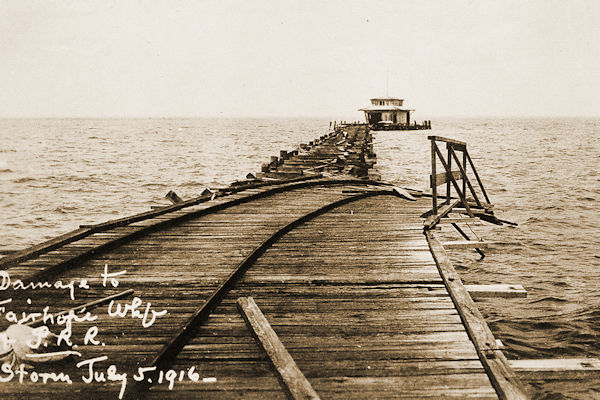
|
Damage to Fairhope wharf & P.R.R. Storm July 5, 1916 - is written at bottom left.
Select to view larger size.
|
In July 1916, a storm swept away part of the wharf, leading to the complete shutdown of the railroad. In September, it was announced that a new car would be put on the track. It was to be 24 feet long by six feet wide using a Hudford form-a-truck attachment mounted on a Ford chassis and powered by a Ford engine. The front of the car would be a four wheel truck. This was Peoples Railway motor car No. 2.
The Peoples Railroad bore little resemblance to a traditional railroad. It was more of a trolley or cable car, without the cables, operating on smaller rails. Unlike conventional trains, it never utilized a genuine train engine or train cars, instead relying on a modified gas-powered motor car. For the first three years the car ran up the hill and into town in forward gears, then back down to the wharf in reverse gear. In November 1917, two turntables were installed, enabling the car to use forward gears for both directions of travel.
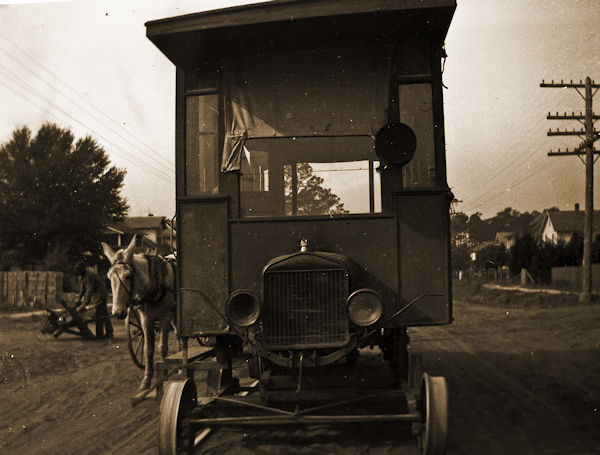
|
The Peoples Railway motor car No. 2 or 3, that both used Ford engines.
Select to view larger size.
|
During operation, the car needed a motorman and conductor. Some of the men that worked in these positions follows.
Elof Tuveson was motorman of the Peoples Railroad car until July of 1915, when Walter Mask took his place. Then in November of 1915, Reuben Rockwell succeeded Walter Mask as engineer. Walter Mask was once again in charge of the railroad car in January 1916. Clyde Warnell conducted the car through the end of 1917. E. A. Knapp drove the car in 1918. Conductors in 1918 included Kenneth Hawes and Jerry Turner. Glen Winberg filled in for E.B. Knapp for a short while in 1920. In 1919, the newspaper reported the fare to ride from the wharf to the Fairhope town center was ten cents. Fives cent was the cost to ride from town to the wharf.
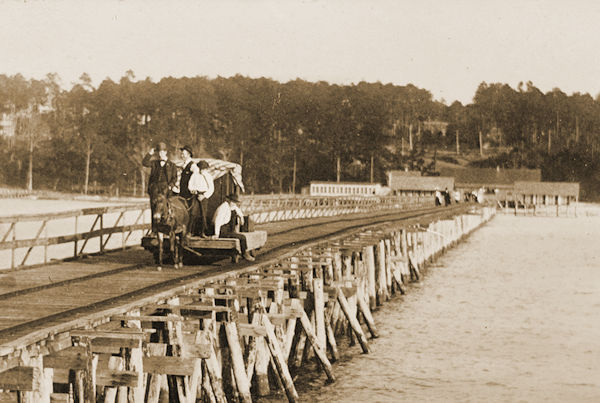
|
E.B. Patterson drives his mule Jack to the pier head carrying cargo to load on a waiting bay boat. Re-engined car No. 2 replaced the mule in September 1920. Car No. 3 continued to carry passengers and mail between the town and the boat.
Select to view larger size.
|

The Peoples Railroad ~ Failure
The founding of The Peoples Railroad stemmed mainly from Ernest B. Gaston's strong conviction in public ownership or cooperative management of vital public services. As the leader of The Peoples Railroad, E.B. Gaston endeavored to establish it as a not-for-profit enterprise. While he garnered moral backing from the community, material support fell short.
E.B. Gaston lead the planning and operations from the beginning and throughout the railroad's existence. In the September 4, 1914 edition of his paper, he gave an account of himself on the road cutting beds for the ties with a pick and shovel. He mentioned he had worked thirty-five years earlier, laying track on a railroad running west from Wellington, Kansas toward Medicine Lodge. That prior experience obviously had helped to give him the confidence to begin a railroad company in Fairhope.
He thought the organization could succeed without a great deal of capital. In the beginning, he only asked for $5 fees and subscriptions. His paper dated October 16, 1914, called the fee "virtually a donation for the purpose of seeing whether or not the road could be built." 250 people had paid fees at that time.
His paper dated April 30, 1915, called these $5 fees membership certificates which bear no interest, but simply gave the holder the right to vote. He also stated that the Peoples Railroad Company would not be able to complete the road if they could not sell all of their bonds. Of the $150,000 that were issued, $15,000 had been sold. The plan for selling bonds were revealed after the Constitution of the Peoples Railroad Company had been presented to the public.
It was in this same issue that E.B. Gaston admitted that people had been asking him if it would be better to build a good highway between Fairhope and Robertsdale and use the new gasoline motor trucks to transport freight instead of a railroad. He disagreed saying that railway transportation was quicker and much more efficient.
During the planning phase of The Peoples Railroad, developments were also underway for the construction of the Mobile Bay causeway. E.B. Gaston was aware of these plans, having printed information about them. The causeway was subsequently completed in 1926.
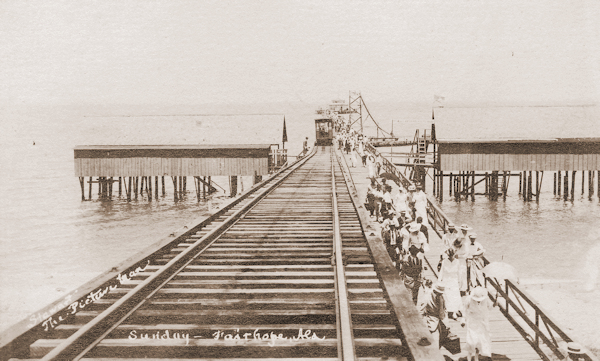
|
A Section of the Peoples Railroad about 1915 that shows the raised railroad running beside the lower pedestrian walkway on the wharf. Written on the left bottom - Stewart The Picture Man. Written in the center bottom - Sunday - Fairhope, Ala.
Select to view larger size.
|
Had E.B. Gaston genuinely desired a railroad linking the bay wharf to the L&N line, a collaboration with the "Northern Capitalists" to begin the western end from the Fairhope shoreline would have been ideal. However, leveraging his newspaper and influence, he swayed public opinion against these willing investors and pursued the establishment of his own railroad company instead. The northern railway experts recognized the impracticality of initiating the railroad from the steep bluff in Fairhope, as it necessitated additional resources and labor to bridge the ravine and connect to the wharf.
Finally in The Fairhope Courier dated February 4, 1921, E.B. Gaston conceded that the Peoples Railroad was not bringing in the amount of revenue need to maintain the cars, tracks, and especially the wharf which were under their care. He also admitted that the funds were not going to be available to connect the railroad to the existing depot in Robertsdale.
In 1922, the railroad stopped all operations. Fiske Warren, who had leased the rails to The Peoples Railroad, reclaimed the rails and sued for the lease money and the bonds in which he had invested.
Due to his socialist beliefs, E.B. Gaston overlooked the significance of financial viability over the mission in this endeavor. Although he effectively utilized his newspaper to reach a broad audience, he struggled to convince those he reached to invest in a company explicitly not aimed at generating profit.
E.B. Gaston had limited foresight regarding the future, unable to anticipate the rise of gasoline-powered cars and trucks, which would eventually supplant trains in various roles. Similarly, he couldn't foresee the onset of World War I, which would dominate public attention, nor the global impact of the Spanish flu pandemic. In hindsight, his vision for the enterprise was indeed short-sighted.
The well being of Silverhill was never the concern of E.B. Gaston, except as a means to accomplish his goal of bettering Fairhope. Silverhill, and the area around it, never saw any railroad ties or rails laid for this project. Anyone investing in this project lost their money.

DOCUMENTS
The Peoples Railroad Company,
Agreement with Fairhope Single Tax Corporation.
Incorporated and Dated February 8, 1913.
~ A PDF File of the Document 
The Peoples Railroad Company,
Memorandum of Agreement with Fairhope Single Tax Corporation.
Dated February 8, 1913.
~ A PDF File of the Document 
Town of Fairhope -vs-
The Peoples Railroad Company.
Complaint filed against
The Peoples Railroad Company for constructing a shed on Fairhope Avenue.
Dated June 26, 1918 - 1919.
~ A PDF File of the Document 
Fiske Warren -vs- Peoples Railroad Company.
Dated 1926.
Also receipts of payments to others. Dated 1924 - 1926
~ A PDF File of the Document 
Agreement between The Fairhope Single Tax Corporation and
The Peoples Railroad Company, ended and executed.
Dated September 14, 1925.
~ A PDF File of the Document 

Newspaper Articles of The Peoples Railroad
These articles mostly pertain to Silverhill and how the railroad affected that area.
Click each clipping to enlarge and expand.

Printed in The Fairhope Courier March 8, 1912. This article expands further.
|

Printed in The Fairhope Courier March 15, 1912. This article expands further.
|

Printed in The Fairhope Courier March 22, 1912. This article expands further.
|

Printed in The Fairhope Courier April 19, 1912. This article expands further.
|
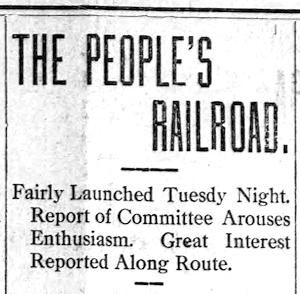
Printed in The Fairhope Courier June 21, 1912, page 1. This article expands further.
|
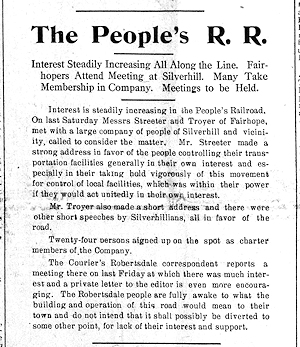
Printed in The Fairhope Courier June 28, 1912. Page 1. This article expands further.
|
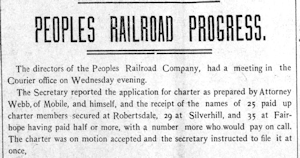
Printed in The Fairhope Courier August 2, 1912. This article expands further.
|
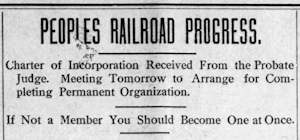
Printed in The Fairhope Courier September 13, 1912. Page 1, section 1. This article expands further.
|
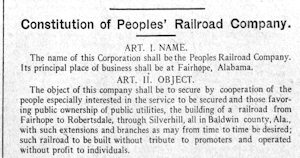
Printed in The Fairhope Courier September 13, 1912. Page 1, section 2. This article expands further.
|
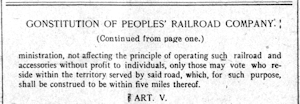
Printed in The Fairhope Courier September 13, 1912. Page 4, section 3. This article expands further.
|
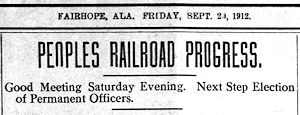
Printed in The Fairhope Courier September 20, 1912. Page 1. This article expands further.
|
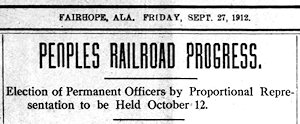
Printed in The Fairhope Courier September 27, 1912. Page 1. This article expands further.
|
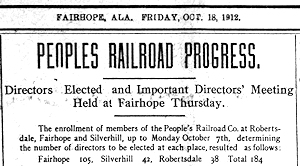
Printed in The Fairhope Courier October 18, 1912. Page 1. This article expands further.
|
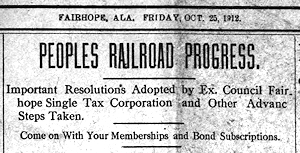
Printed in The Fairhope Courier October 25, 1912. Page 1. This article expands further.
|
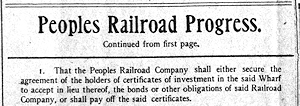
Printed in The Fairhope Courier October 25, 1912. Page 4. This article expands further.
|
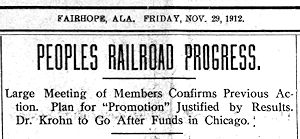
Printed in The Fairhope Courier November 29, 1912. Page 1. This article expands further.
|
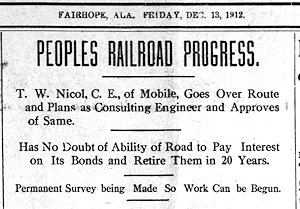
Printed in The Fairhope Courier December 13, 1912. Page 1. This article expands further.
|
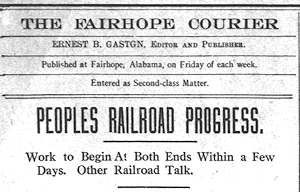
Printed in The Fairhope Courier December 27, 1912. Page 1. This article expands further.
|
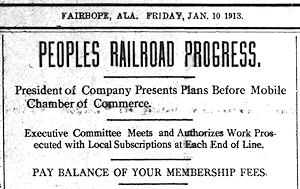
Printed in The Fairhope Courier January 10, 1913. Page 1. This article expands further.
|
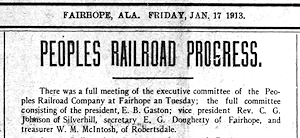
Printed in The Fairhope Courier January 17, 1913. Page 1. This article expands further.
|
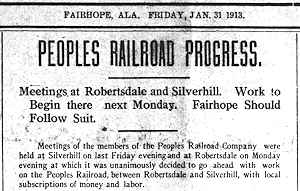
Printed in The Fairhope Courier January 31, 1913. Page 1. This article expands further.
|
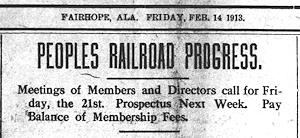
Printed in The Fairhope Courier February 14, 1913. Page 1. This article expands further.
|
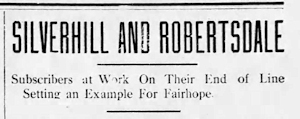
Printed in The Fairhope Courier February 21, 1913. Page 1 and 4. This article expands further.
|
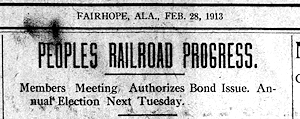
Printed in The Fairhope Courier February 28, 1913. Page 1. This article expands further.
|
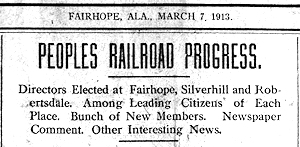
Printed in The Fairhope Courier March 7, 1913. Page 1. This article expands further.
|
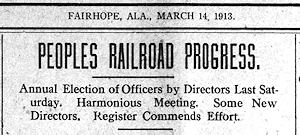
Printed in The Fairhope Courier March 14, 1913. Page 1. This article expands further.
|
|
|
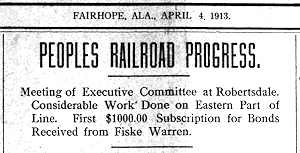
Printed in The Fairhope Courier April 4, 1913. Page 1. This article expands further.
|
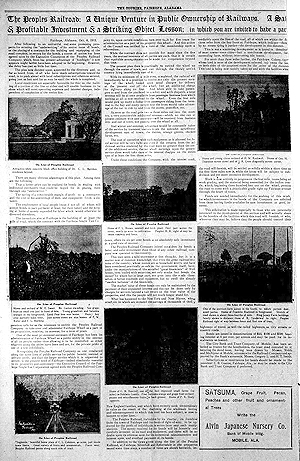
Printed in The Fairhope Courier October 10, 1913. Page 4. This article expands further.
|
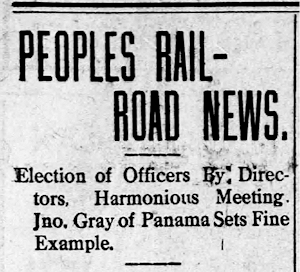
Printed in The Fairhope Courier March 20, 1914. Page 1. This article expands further.
|

Printed in The Fairhope Courier October 16, 1914. Page 1. This article expands further.
|
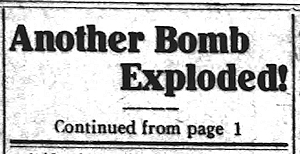
Printed in The Fairhope Courier October 16, 1914. Page 4. This article expands further.
|
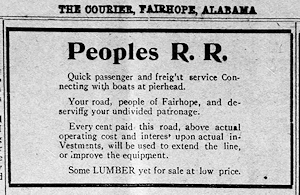
Printed in The Fairhope Courier October 23, 1914. Page 4. This article expands further.
|
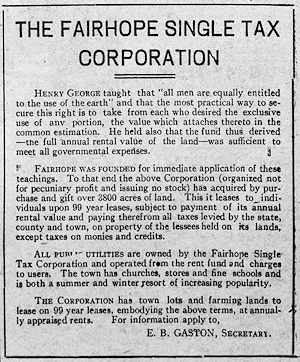
Printed in The Fairhope Courier October 23, 1914. Page 4. This article expands further.
|
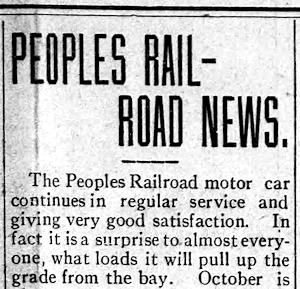
Printed in The Fairhope Courier November 6, 1914. Page 1. This article expands further.
|
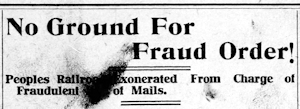
Printed in The Fairhope Courier November 13, 1914. Page 1. This article expands further.
|
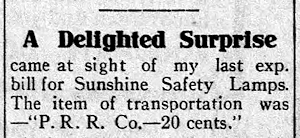
Printed in The Fairhope Courier November 20, 1914. Page 4. This article expands further.
|
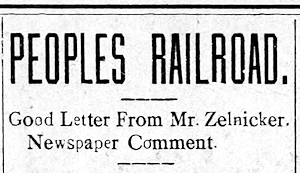
Printed in The Fairhope Courier November 27, 1914. Page 1. This article expands further.
|
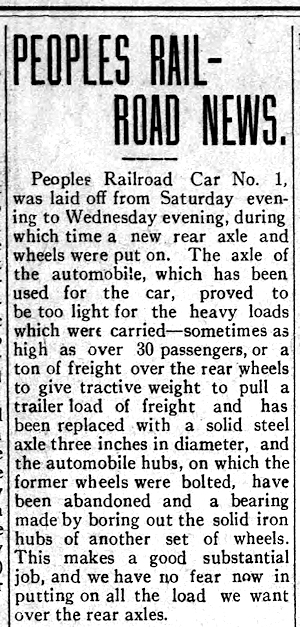
Printed in The Fairhope Courier December 4, 1914. Page 1. This article expands further.
|
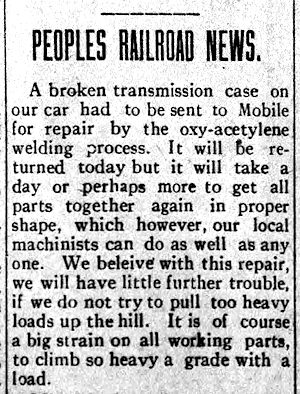
Printed in The Fairhope Courier December 18, 1914. Page 4. This article expands further.
|
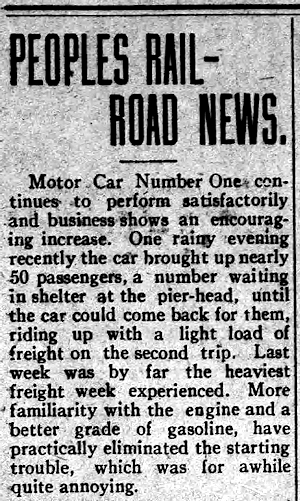
Printed in The Fairhope Courier January 22, 1915. Page 1. This article expands further.
|
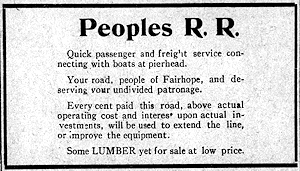
Printed in The Fairhope Courier February 5, 1915. Page 8. This article expands further.
|
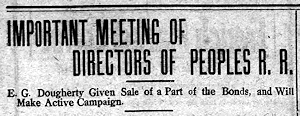
Printed in The Fairhope Courier February 26, 1915. Page 1. This article expands further.
|
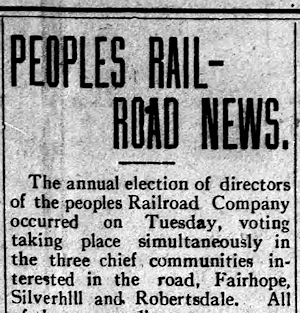
Printed in The Fairhope Courier March 12, 1915. Page 1. This article expands further.
|
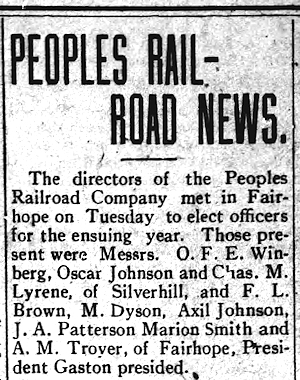
Printed in The Fairhope Courier March 19, 1915. Page 1. This article expands further.
|
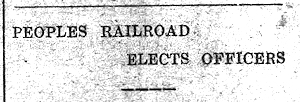
Printed in The Foley Onlooker March 24, 1915. Page 1. This article expands further.
|

Printed in The Fairhope Courier April 23, 1915. Page 1. This article expands further.
|
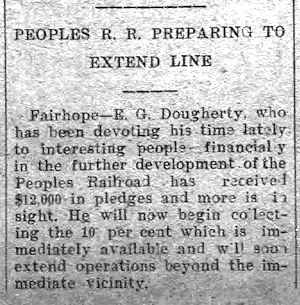
Printed in The Foley Onlooker April 28, 1915. Page 1. This article expands further.
|

Printed in The Fairhope Courier April 30, 1915. Page 1. This article expands further.
|
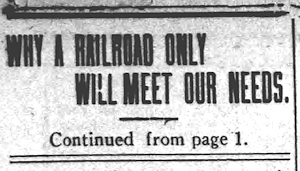
Printed in The Fairhope Courier April 30, 1915. Page 8. This article expands further.
|
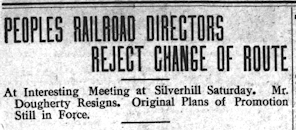
Printed in The Fairhope Courier May 21, 1915. Page 1. This article expands further.
|
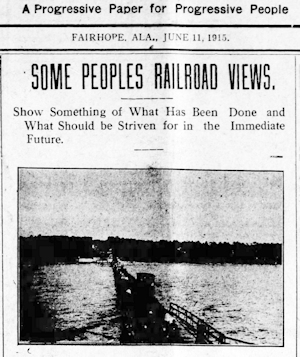
Printed in The Fairhope Courier June 11, 1915. Page 1. This article expands further.
|
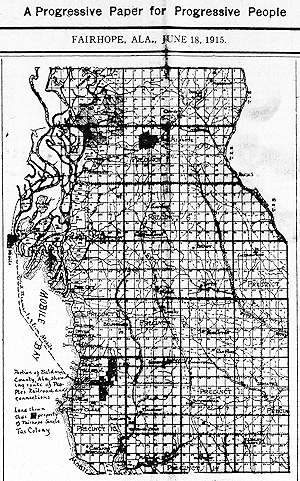
Printed in The Fairhope Courier June 18, 1915. Page 1. This article expands further.
|
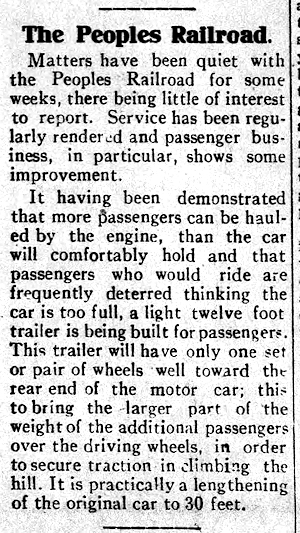
Printed in The Fairhope Courier July 16, 1915. Page 8. This article expands further.
|
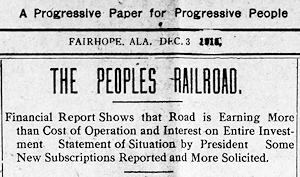
Printed in The Fairhope Courier December 3, 1915. Page 1. This article expands further.
|
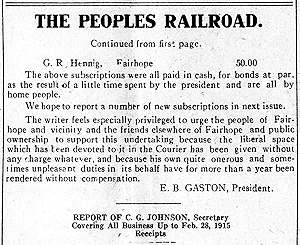
Printed in The Fairhope Courier December 3, 1915. Page 4. This article expands further.
|
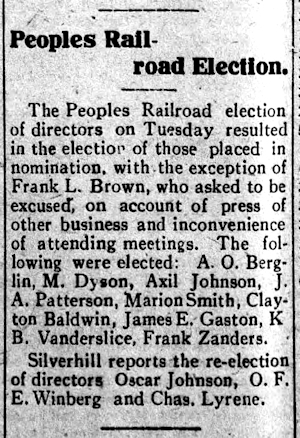
Printed in The Fairhope Courier March 10, 1916. Page 5. This article expands further.
|
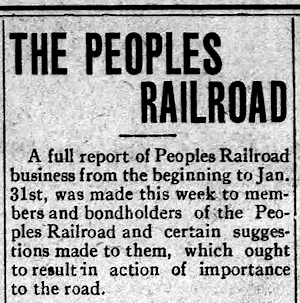
Printed in The Fairhope Courier April 14, 1916. Page 1. This article expands further.
|
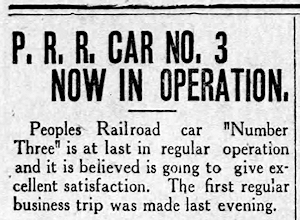
Printed in The Fairhope Courier November 2, 1917. Page 1. This article expands further.
|
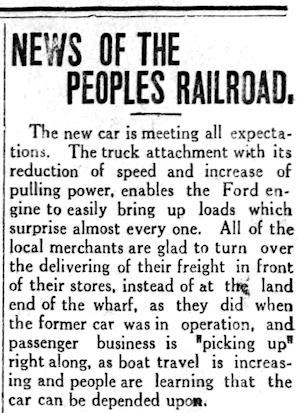
Printed in The Fairhope Courier November 9, 1917. Page 1. This article expands further.
|
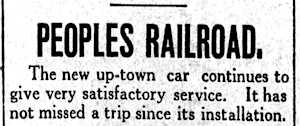
Printed in The Fairhope Courier December 7, 1917. Page 1. This article expands further.
|
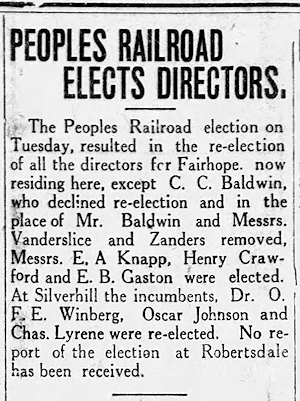
Printed in The Fairhope Courier March 9, 1918. Page 1. This article expands further.
|
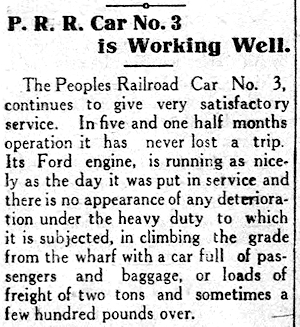
Printed in The Fairhope Courier April 12, 1918. Page 2. This article expands further.
|
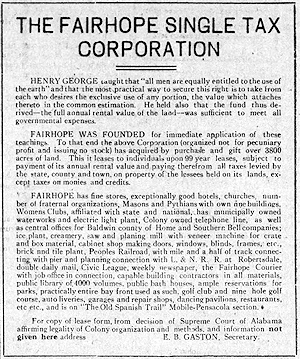
Printed in The Fairhope Courier June 21, 1918. Page 2. This article expands further.
|
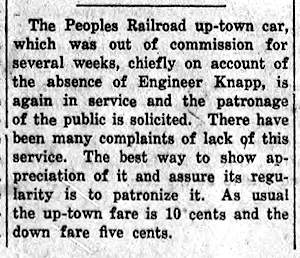
Printed in The Fairhope Courier October 31, 1919. Page 1. This article expands further.
|
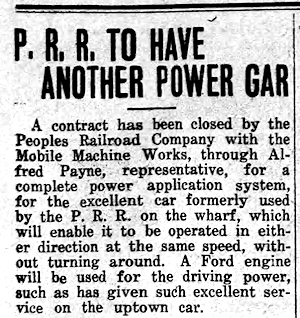
Printed in The Fairhope Courier July 23, 1920. Page 1. This article expands further.
|

Printed in The Fairhope Courier February 4, 1921. Page 4. This article expands further.
|
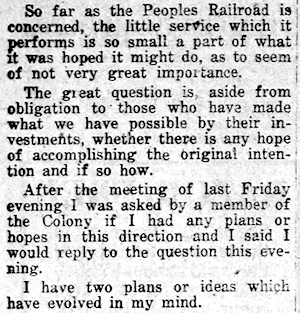
Printed in The Fairhope Courier February 4, 1921. Page 8. This article expands further.
|
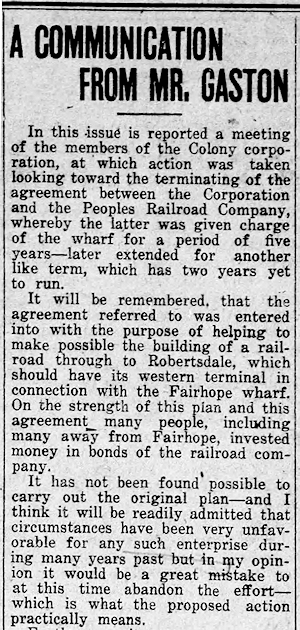
Printed in The Fairhope Courier February 4, 1921. Page 1. This article expands further.
|

Printed in The Fairhope Courier May 6, 1921. Page 1. This article expands further.
|
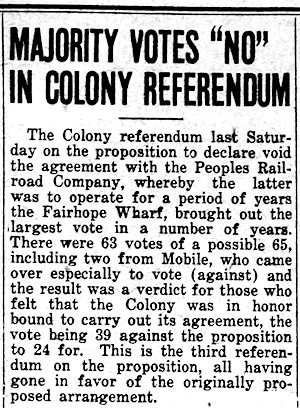
Printed in The Fairhope Courier May 13, 1921. Page 1. This article expands further.
|
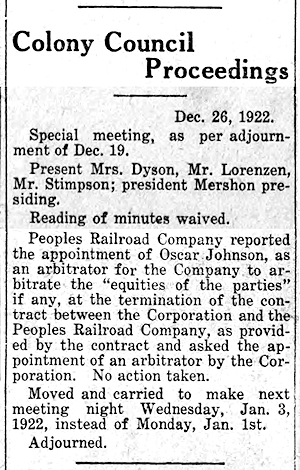
Printed in The Fairhope Courier December 29, 1922. Page 8. This article expands further.
|
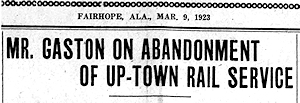
Printed in The Fairhope Courier March 9, 1923. Page 1. This article expands further.
|

Printed in The Fairhope Courier March 9, 1923. Page 8. This article expands further.
|

Printed in The Fairhope Courier March 23, 1923. Page 3. This article expands further.
|
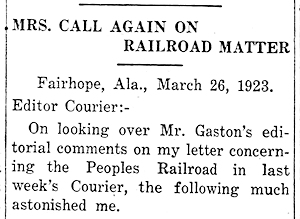
Printed in The Fairhope Courier March 20, 1923. Page 2. This article expands further.
|
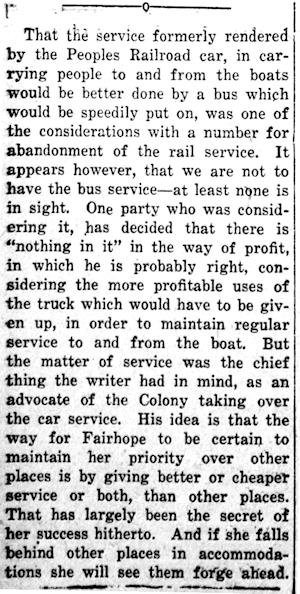
Printed in The Fairhope Courier April 13, 1923. Page 4. This article expands further.
|
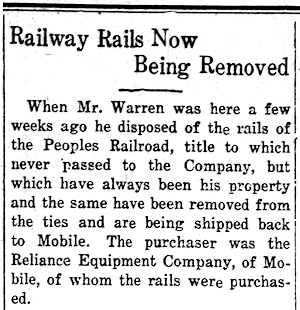
Printed in The Fairhope Courier July 13, 1923. Page 1. This article expands further.
|
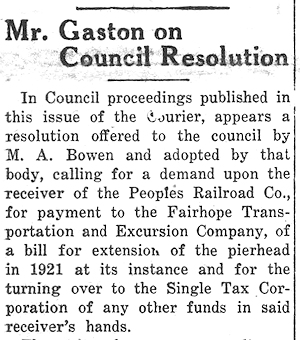
Printed in The Fairhope Courier May 30, 1924. Page 1. This article expands further.
|
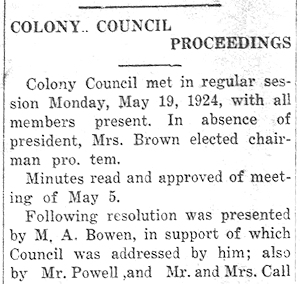
Printed in The Fairhope Courier May 30, 1924. Page 2. This article expands further.
|
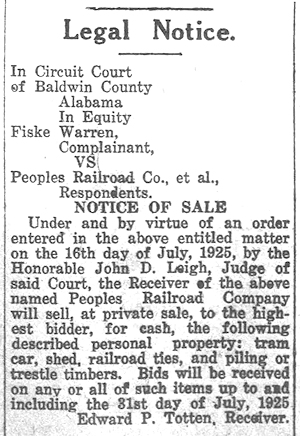
Printed in The Fairhope Courier July 24, 1925. Page 3. This article expands further.
|
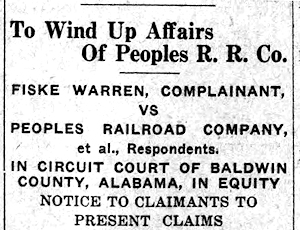
Printed in The Fairhope Courier March 11, 1926. Page 8. This article expands further.
|
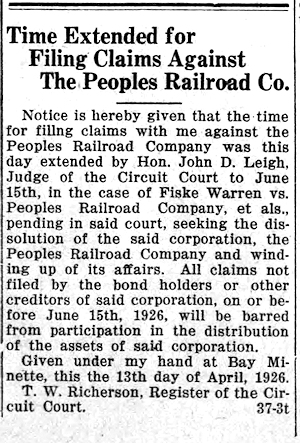
Printed in The Fairhope Courier April 22, 1926. Page 1. This article expands further.
|
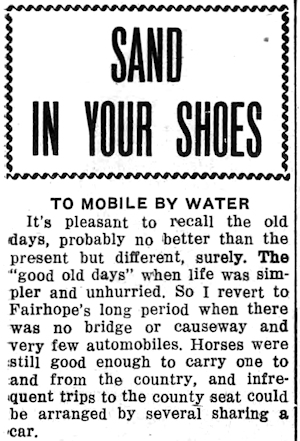
Printed in The Fairhope Courier September 10, 1953. Page 1. This article expands further.
|

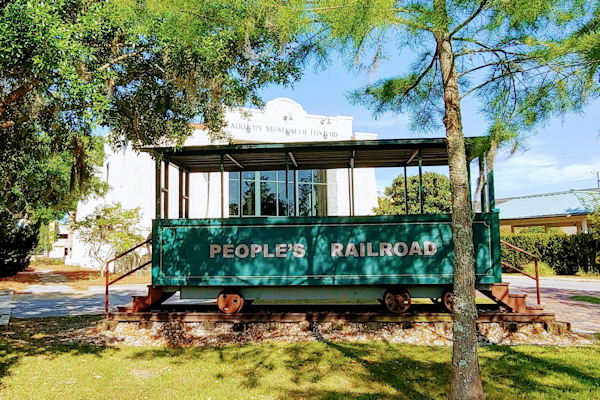
|
A replica of the Peoples Railroad car No. 1 at the Fairhope Museum of History.
Select to view larger size.
|

Gaston family competes with Peoples Railroad
|
In addition to the conflict of interest stemming from E.B. Gaston's multiple roles as the editor of The Fairhope Courier, secretary of the Fairhope Single Tax Colony, and President of The Peoples Railroad Company, another conflict arose due to his son's ownership of an automobile business.
Just as the railroad was beginning operations in September 1914, his oldest son, James E. Gaston began the automobile service originally established as Gaston’s Auto Livery. The company was renamed Gaston’s Garage in 1916 and began to sell Ford motor cars. J.E. Gaston became an authorized Ford dealer in 1923 and renamed his company Gaston Motor Co. In 1924, a showroom was added to the building.
|
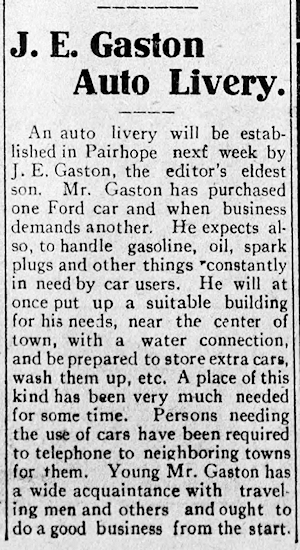
Printed in The Fairhope Courier September 4, 1914.
(Select to read entire article and view in larger size.)
|
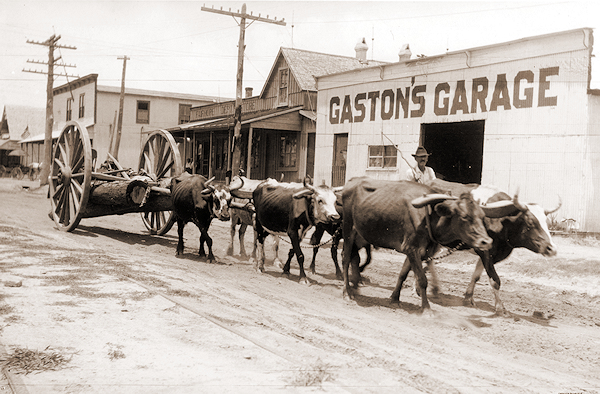
|
|
Oxen are driven past Gaston’s Garage, owned by James E. Gaston Sr.
|
J.E. Gaston's automobile business would have certainly seen a potential increase in business if The Peoples Railroad were to cease operations.
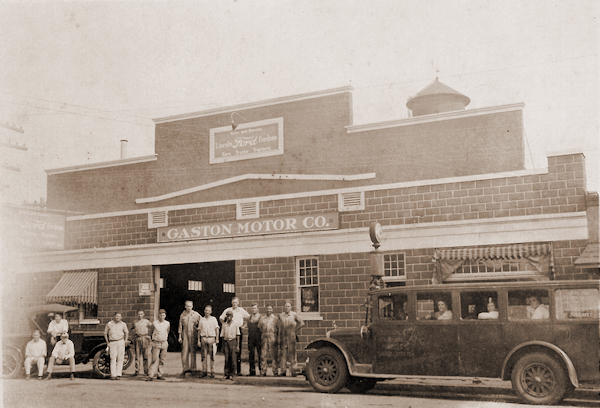
|
Gaston Ford Motor Company.
Select to view larger size.
|
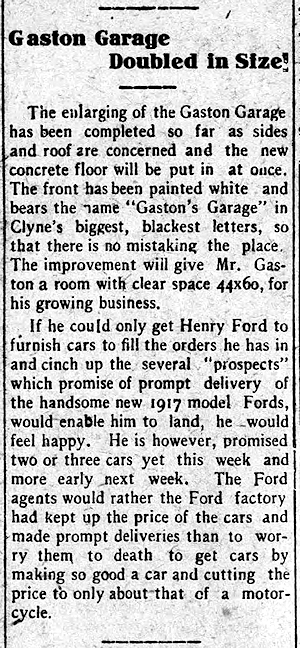
Printed in The Fairhope Courier October 6, 1916. (Select to view larger size.)
|
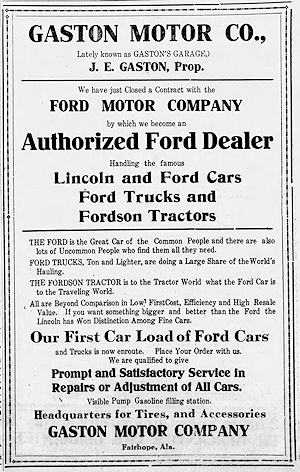
Printed in The Fairhope Courier August 24, 1923.
(Select to view larger size.)
|

Written by Debbie Owen
April 2024

Resources
ChatGPT, ChatGPT 3.5 version, OpenAI, March - April 2024, "ChatGPT was used to revise content, and in the correction of spelling and grammar."
https://openai.com/
Creighton C. "Peco" Forsman, "She's Bound to Be a Goer!", Fairhope Alabama and the Steamboats of Mobile Bay 1894-1934. (Creekhouse Publishing, Silverhill, Alabama, 2014)

|